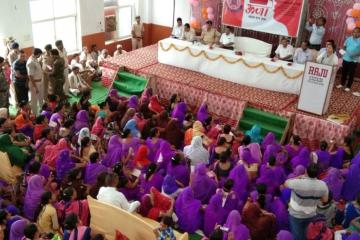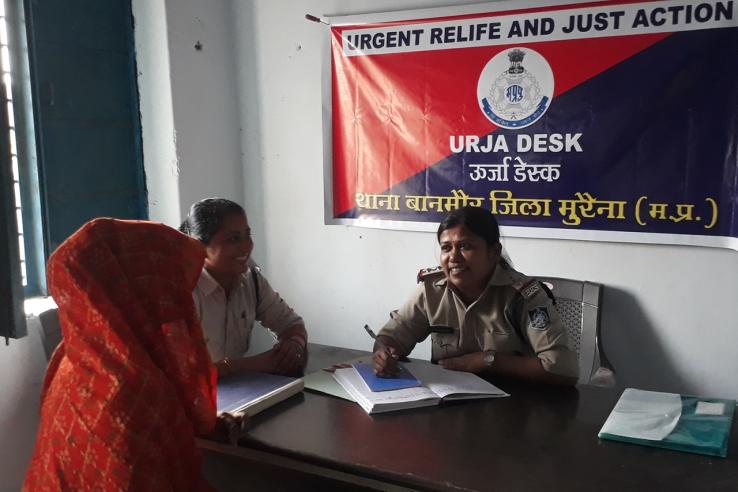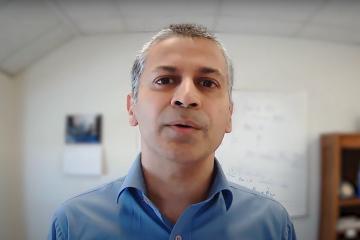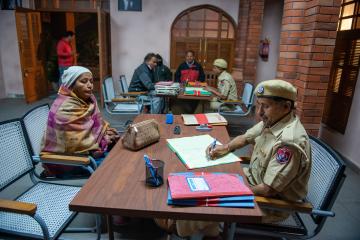
Researcher Spotlight: Sandip Sukhtankar on his work in India

This podcast and blog series brings together researchers reflecting on their experiences conducting impact evaluations in India. From working in diverse local contexts to engaging with government and civil society, each episode offers a window into the realities of producing policy-relevant evidence on the ground.
In this episode of the Researcher Spotlight Conversation Series, host Sambhav Choudhury speaks with J-PAL affiliated professor Sandip Sukhtankar, Professor of Economics at the University of Virginia. He discusses the unique challenges and rewards of conducting research with law enforcement agencies, offers practical strategies for maintaining government partnerships despite personnel changes, and explores the nuanced role of technology in social protection programs.
Want to learn more? Explore other podcast episodes in this series where we speak with Shobhini Mukerji on her journey into development economics, Ariel Zucker on applying economic theory to real-world solutions, Harini Kannan on scaling evidence-informed programs with governments, and Gautam Rao on co-producing evidence with policymakers.
Listen to our conversation
[Transcript]
Sambhav Choudhury: Hi everyone, welcome to an episode of J-PAL South Asia's Researcher Spotlight conversation series. My name is Sambhav Choudhury, and I am a research associate at J-PAL South Asia. Today I'm talking to Sandip Sukhtankar, who is a professor in the Economics Department at the University of Virginia. His research interests are in development economics, political economy, and public economics, with a particular focus on corruption, governance, and the delivery of public benefits and services. Sandip's non-academic interests are as exciting as his research. He's an avid cricket fan since childhood and is now also a practicing ceramicist. Research associates that work with him are regularly in awe of how Zen he is. Hi Sandip, thanks for talking to us today.
Sandip Sukhtankar: Hi Sambhav, thanks for having me.
Sambhav: The first question that we have for you is relating to your paper "Increasing Access to Security and Justice Through Women's Help Desks in Police Stations in India," in which you study the impact of women help desks on registration rates of cases of gender-based violence. Can you briefly tell us how it was working on this project in India and some of the advantages and challenges of running an intervention in this context?
Sandip: Sure. This has been a very, very interesting project for me. It's the first project in which I've worked with the police, and I knew very little about the police before I started working with them. So, for example, the fact that police in India generally don't get any leave—like during the week, Sunday is not off, holidays that other people get are not off. In fact, that means double time for them since they're working policing festivals or whatever else there is.
So it's a very interesting context, and I'm really glad that it worked out. And the way it worked out was also super interesting because it was not us reaching out to them, but it was the Madhya Pradesh Police Department reaching out to Iqbal, and then J-PAL and Iqbal and Abhijit bringing me on to meet with them.
It was super interesting to work in this context. I think it worked because of the stakeholder interest. Otherwise, I think it would be very challenging because even after we had very strong support within the police, there were also other factions who were not as keen on working with researchers and not as keen on sharing data or being open to running an intervention that might fail and then have us write a paper that suggests that there was something that didn't work.
Now in this case, some parts of the intervention did work, and the paper got published very nicely, and they got some nice publicity out of it too. So I think it all worked out, but there's lots of advantages and challenges of running an experiment with a sector like the police, which is very understudied and super, super interesting.
Sambhav: Thanks, Sandip. So often when we work on projects with governments, there are personnel changes within the department and new stakeholders that we have to work with for the same project. So in your experience, what key factors or strategies have proven effective in maintaining strong partnerships with government departments despite this barrier?
Sandip: Yes, this—as anyone who's worked with the government knows—this is one of the biggest challenges: the change in personnel. You'll have a secretary or joint secretary who's super enthusiastic about experiments or research and will be giving you all support, and you're just about ready to launch your project, and they get transferred.
So this is a situation that all of us have faced, and I think there's ways in which you can prepare, but I think we have to be open to the fact that this is just the arena in which we work, and if things don't work out, they won't work out.
But some of the things that we can do to avoid them—I think having written MoUs and a file in the government is always important. Government puts a lot of stock in paperwork, so an existing file that's been there on the project and sitting and signed off on somehow has some cache. I'm not saying it has all the cache, but I think it has some cache.
And then I think just building personal relationships with people who will be there for a longer term, maybe people who are either higher or lower in the hierarchy than, say, the secretary. So either way, you can use those connections and relationships to keep building, keep the continuity in the project going.
So I think those are probably the two things that are most effective, but nothing, of course, is foolproof.
Sambhav: You're also one of the researchers on the Payments and Governance Research Program that aims to understand the impact of direct benefits transfers models on public finances and the effectiveness of anti-poverty programs. In this context, could you throw some light on how technology has helped you in exploring these ideas?
Sandip: Yeah, so technology is very interesting. In fact, I just finished writing a handbook chapter on digital technology in social protection. And I think what I've learned, and what we as researchers who work in this area have learned, is that technology by itself doesn't really do anything good or bad, right? It's the protocols around its use, it's how it's being employed that really matters.
So, for example, take the case of using Aadhaar-based authentication to authenticate beneficiaries getting some kind of benefit. You could, on the one hand, it could reduce fraud and corruption. On the other hand, it could increase exclusion, right? The people who may not have Aadhaar or whose fingerprints don't get authenticated may stand to lose their benefits.
And so in this case, the success overall of the technology is based on what protocols do you have in place to, let's say, figure out, stop workarounds to and prevent corruption. What protocols do you have in place as backups for people who cannot authenticate? And these tend to be the most vulnerable, right? So how can you protect them?
So I think the big takeaway on technology is just that you need to be careful about designing the protocols, and it's how you use it that can lead to benefits or potential disadvantages.
Sambhav: Thanks, Sandip. So, given your extensive fieldwork experience in South Asia, what advice would you offer to emerging researchers or budding economists interested in pursuing a career in development economics?
Sandip: I think probably just be open to questions and be observant, and research questions can come from anywhere. You know, they're often not going to come to you from reading economics papers. They're probably going to come to you from interesting conversations that you have with random people, or something that you notice as a pattern when you're traveling.
So, in that sense, for me at least, I think there is no substitute to actually being in the field and talking to people and observing how programs are working or how they're not working.
So I feel, for example, I feel particularly energized—I just spent a few days in JPAL and in Madhya Pradesh doing sort of extending some of the research we've been doing as well as trying to start off new projects. So I ended up speaking to something like 300 newly recruited constables in the police force, and it was just really, really interesting to see their perspective and hear about their complaints as well as how they feel about working on the job, and then link that to what's going on with labor markets in India overall.
So yeah, I think something like this is fantastic for generating ideas.
Sambhav: Thanks, Sandip, that's quite fascinating. The final question that I had for you was: what research projects or areas are you currently excited about or planning to explore in the near future?
Sandip: Yeah, so that's a great segue since the project that I was trying to launch in Bhopal is something that I'm very excited about. It involves newly recruited constables in the Madhya Pradesh police, but from the angle of female labor force participation.
And these, as you might know, any government job is sort of super valued. So about a million people applied for 6,000 or so positions. But even after that, a fair number of them drop out for other lucrative government positions or other issues, especially in the cases of the women constables if they're posted far from home or don't have the support networks and things like that.
So some of the things that we're trying to do are looking at interventions that might help the police retain these women constables, help them improve job satisfaction, and of course, overall performance in the police.
So I think that's super interesting given the broad context of unemployment in India as well as female labor force participation in India. And I think there's lots of fascinating, just some fascinating descriptive work that we can do as well as the experimental work.
Sambhav: Yeah, that sounds quite interesting, and as someone who's interested in labor markets, I look forward to reading more about this project. Thank you, Sandip, that was quite interesting, and thank you for this conversation.
Sandip: Great, thanks.
Related Content

Affiliate Spotlight: Sandip Sukhtankar on his path to becoming a economist and the value of interdisciplinary collaboration

Lessons from gender-sensitive police reform in India: A Q&A with Sandip Sukhtankar on his new paper in Science

